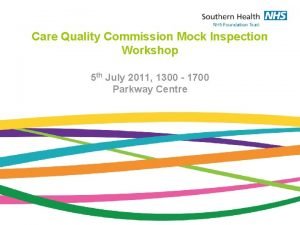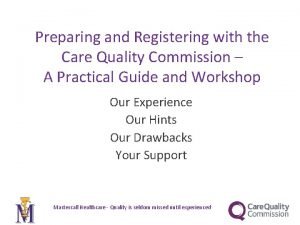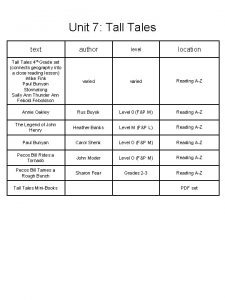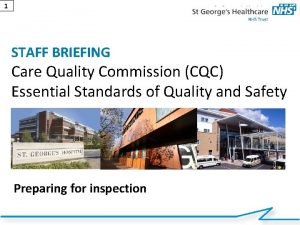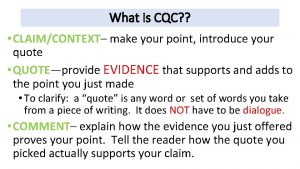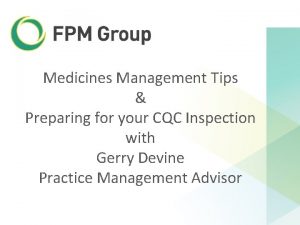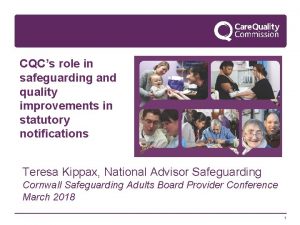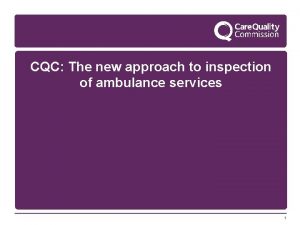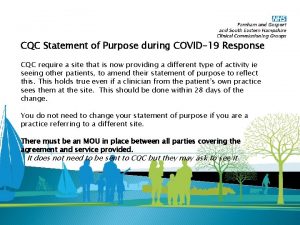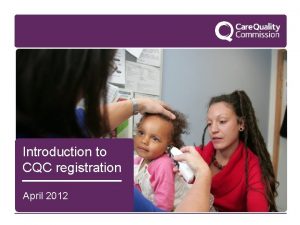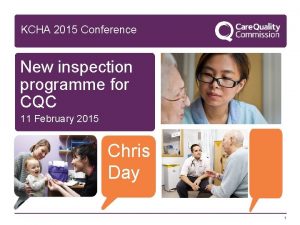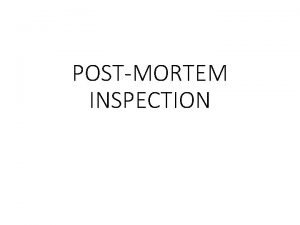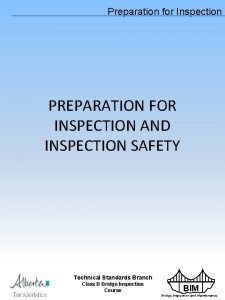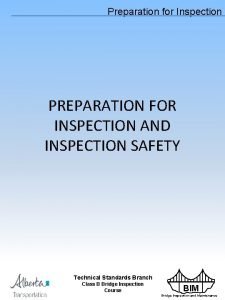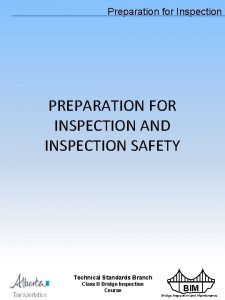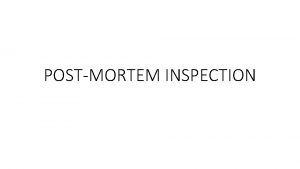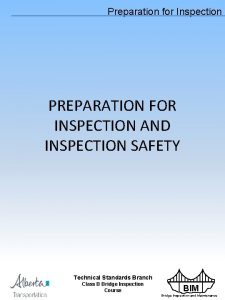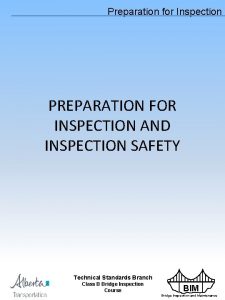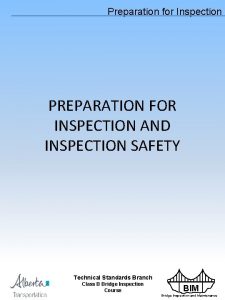The new CQC approach to hospital inspection Ann

















- Slides: 17

The new CQC approach to hospital inspection Ann Ford Head of Hospital Inspection (North West) 1

Our purpose and role Our purpose We make sure health and social care services provide people with safe, effective, compassionate, high-quality care and we encourage care services to improve Our role We monitor, inspect and regulate services to make sure they meet fundamental standards of quality and safety and we publish what we find, including performance ratings to help people choose care 2

Our New Approach We ask these questions of all services: • • • Is it safe? Is it effective? Is it responsive? Is it caring? Is it well led? 3

The new CQC hospital inspection programme • We have retained the positive elements of our earlier approach in particular in relation to rigorous evidence gathering. • We have built on the Keogh Reviews process for 14 acute hospitals with high mortality. • We aim to be robust, fair, transparent and (hopefully) helpful. • Work with partners to secure improvement. 4

The new approach: Acute hospital inspections 3 Phases: • Pre-inspection: Development of data pack Recruitment of team • Inspection: 8 core services , less for specialists. 5 key questions Large team: Around 30 people. Visits to clinical areas + focus groups, listening events and interviews • Post inspection: Report writing Confirmation of ratings Quality Summit 5

Core Services There are 8 core services for Acute Hospitals A&E Medical Care Surgical Care & Theatres Critical Care Maternity & Family Planning Children and Young People’s Care End of Life Care Outpatients 6

Core Services Mental Health Acute wards Psychiatric intensive care units (PICUs) Long stay / rehabilitation wards Health-based places of safety Forensic inpatient / secure wards 3 Child and adolescent mental health services (CAMHS) Services for older people Services for people with learning disabilities or autism Adult community-based services Community-based crisis services Specialist eating disorder services Other specialist services 7

Data packs • We collate as much information as possible on the 5 key questions and 8 core services • Examples include: • Safety: STEIS; NRLS; infection rates; safety • • Effectiveness: Mortality (HSMR/SHMI); National Clinical Audits Caring: CQC Inpatient Survey; Friends + Family Test Responsiveness: Waiting times; Cancellations; Discharges Well led: Staff survey; Staff sickness rates, Governance thermometer 8

Differences in the Methods Differences in inspection methods. • In mental health due to the restrictions placed on patients who are detained the larger listening type event are replaced with targeted involvement from community groups. We also run patient focus groups and drop in sessions to ensure that we are able to capture the views of people who use services. • We include Mental Health Act monitoring visits as part of the comprehensive inspection and there are sections in the report that cover our finding of adherence to the Mental Health and Mental Capacity Acts. 9

CQC’s 5 key questions Safe? Are people protected from abuse and avoidable harm? Effective? outcomes evidence- Does people’s care and treatment achieve good and promote a good quality of life, and is it based where possible? Caring? Do staff involve and treat people with compassion, kindness, dignity and respect? Responsive? Are services organised so that they meet people’s needs? Well-led? Does the leadership, management and governance of the organisation assure the delivery of high-quality patientcentred care, support learning and innovation and promote an open and fair culture? 10

Inspection Teams • • • Chair Team Leader Doctors (senior and junior) Nurses (senior and junior) AHPs/Managers Experts by experience (patients and carers) CQC Inspectors Analysts Programme management support 11

Rationale for ratings • The public and patients want information about the quality of services presented in a way that is easy to understand • The approach taken by Ofsted is seen as a model, though we recognise that hospitals are more complex than schools. • Patients/public may, for example, be interested in a particular service (e. g. Medicine, surgery) rather than a single global rating • Ratings of services and of Trusts should hopefully be a driver for improving services and patient outcomes. 12

Ratings: Approach • A four point scale will be used for all ratings • Outstanding • Good • Requires Improvement • Inadequate • Ratings will always take account of all sources of information • Intelligent monitoring tool • Information provided by Trust • Other data sources and intelligence e. g. CCGs • Findings from site visits • Direct observations • Staff focus groups • Patient and public listening events • Interviews with key people 13

Ratings: Approach • Bottom up approach: Rate each of the core services on each of the five key questions (safe, effective, caring, responsive, well led). • Then rate the Trust as a whole on the five key questions, including an overall assessment of well led at Trust level. • Derive a final overall rating. 14

Ratings Grid Safe Effective Caring Responsive Well-led Overall Accident & Emergency RI NSE G RI RI RI Medical care G G G RI G G Surgery G G RI RI G RI Intensive/critical care G G G RI G G Maternity & family planning G G G Children's care G G G End of Life G G G Outpatients G NSE G G G RI Overall G G 15

Summary • The new approach is a major change • Our evidence is that hospitals have already made improvements as a result of these inspections • The process is dynamic and we are open to feedback and suggestions • We are committed to continuous improvement 16

Thank you for your time Any Questions ? 17
 Cqc mock inspection template
Cqc mock inspection template Cqc mock inspection toolkit
Cqc mock inspection toolkit Ann ford cqc
Ann ford cqc John henry tall tale pdf
John henry tall tale pdf Anne hathaway sonnet
Anne hathaway sonnet New-old approach to creating new ventures
New-old approach to creating new ventures What does chloe mean in care
What does chloe mean in care Cqc fundamental standards
Cqc fundamental standards Cqc kloe questions
Cqc kloe questions What is cqc
What is cqc Cqc training near me
Cqc training near me Cqc medicines management
Cqc medicines management Cqc safeguarding notification
Cqc safeguarding notification Requirement of pharmacist in hospital
Requirement of pharmacist in hospital Philip said i was playing football in reported speech
Philip said i was playing football in reported speech Difference between datagram and virtual circuit operation
Difference between datagram and virtual circuit operation Theoretical models of counseling
Theoretical models of counseling Waterfall strategy
Waterfall strategy
